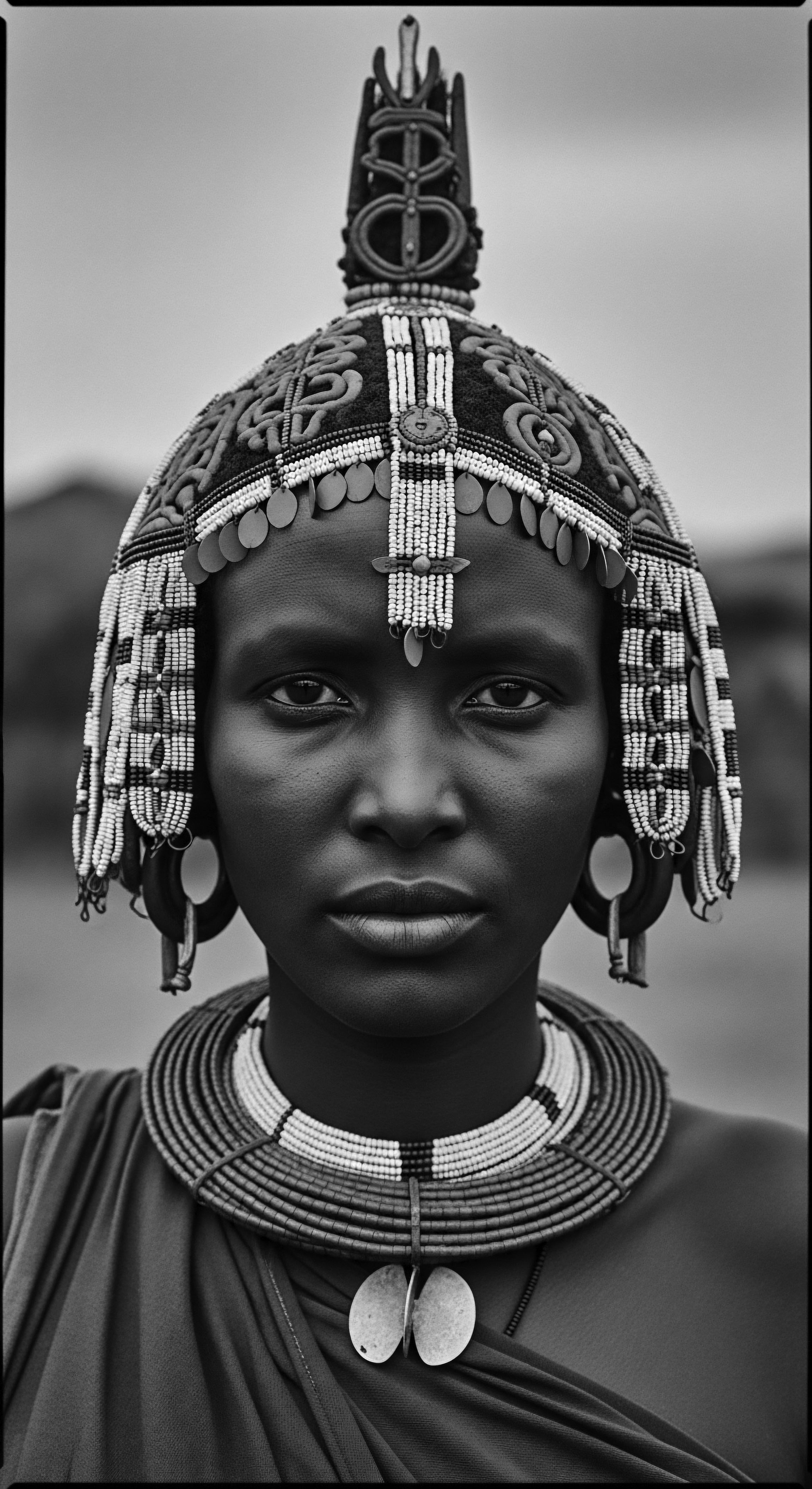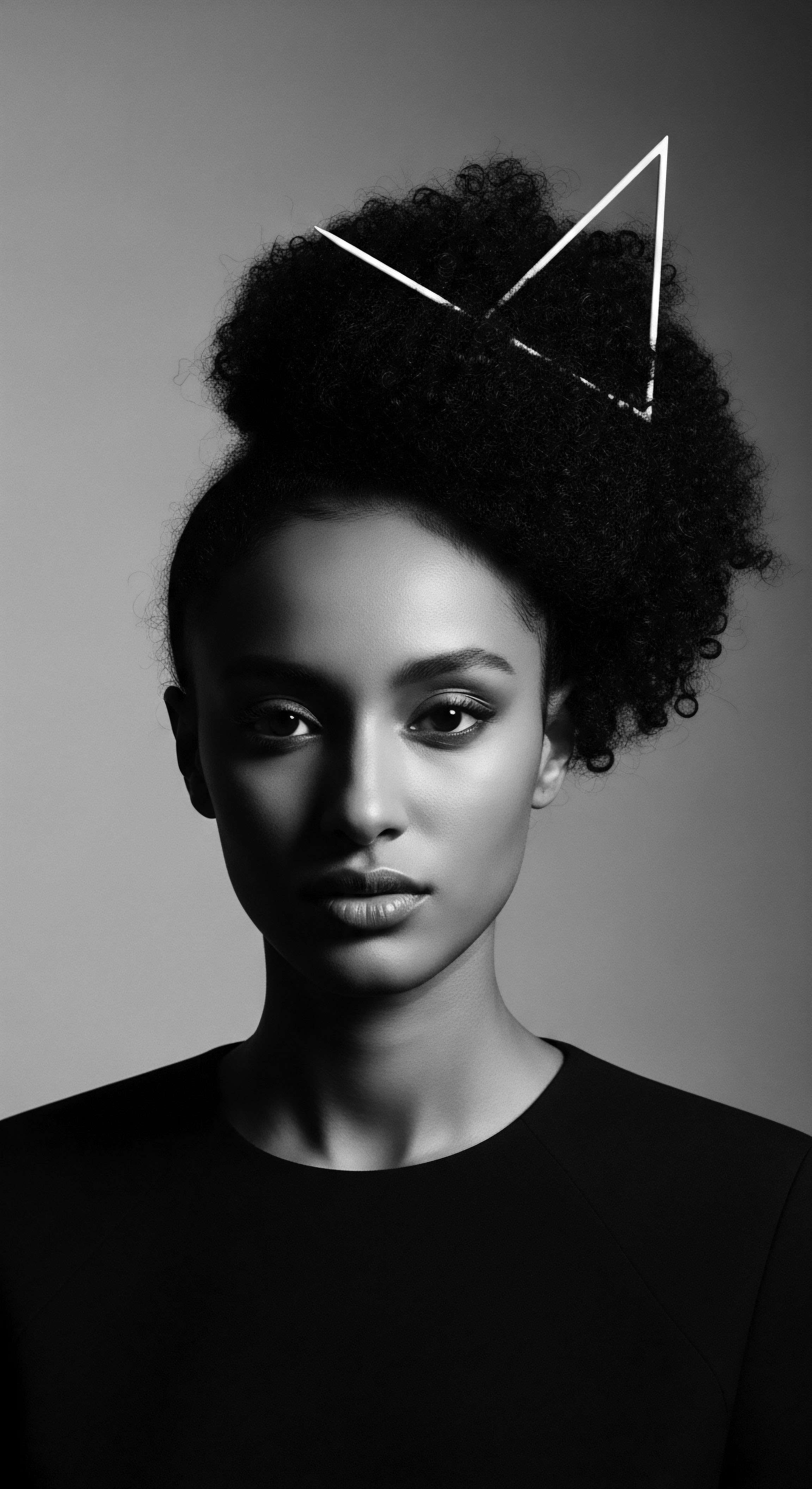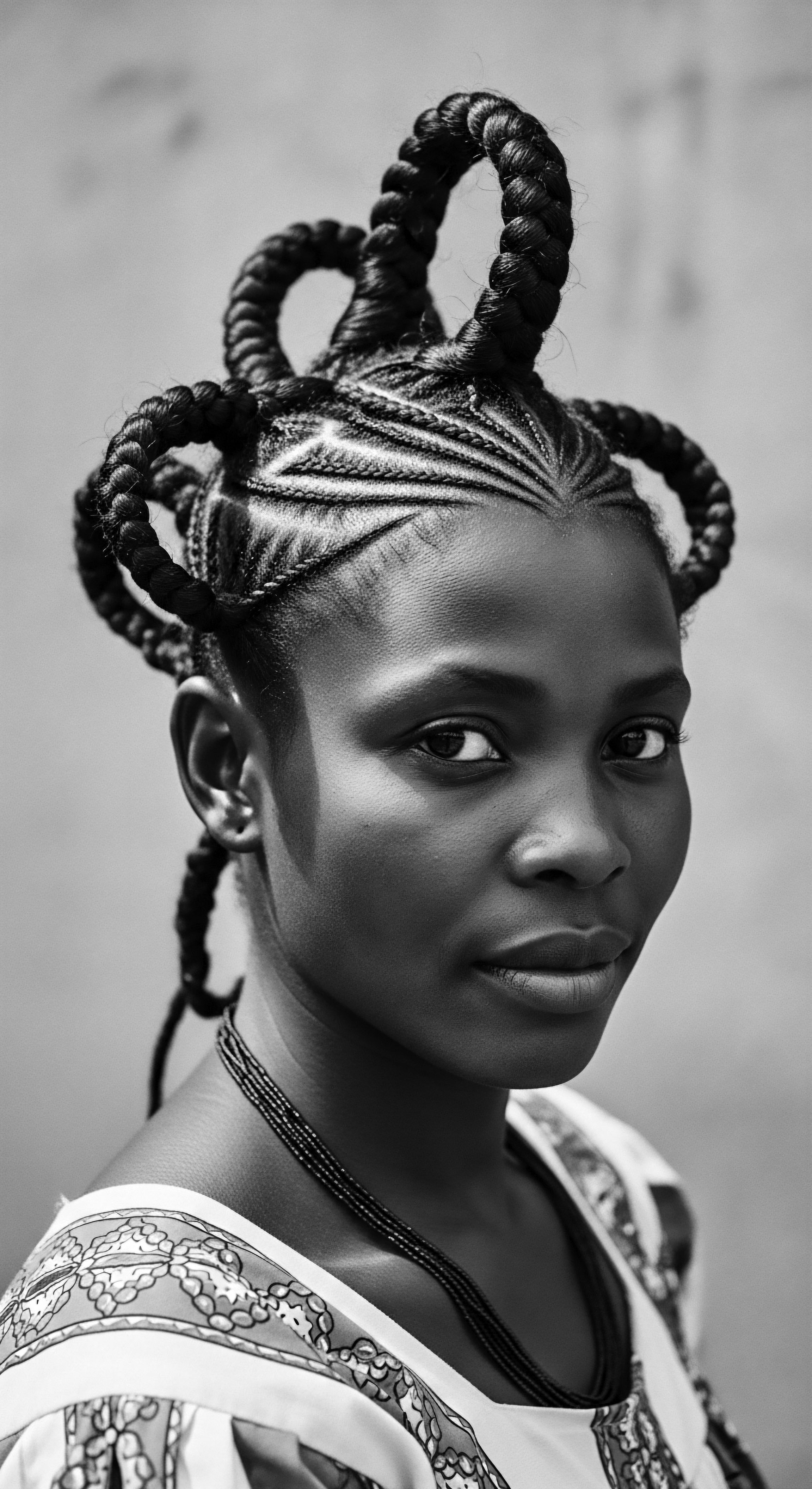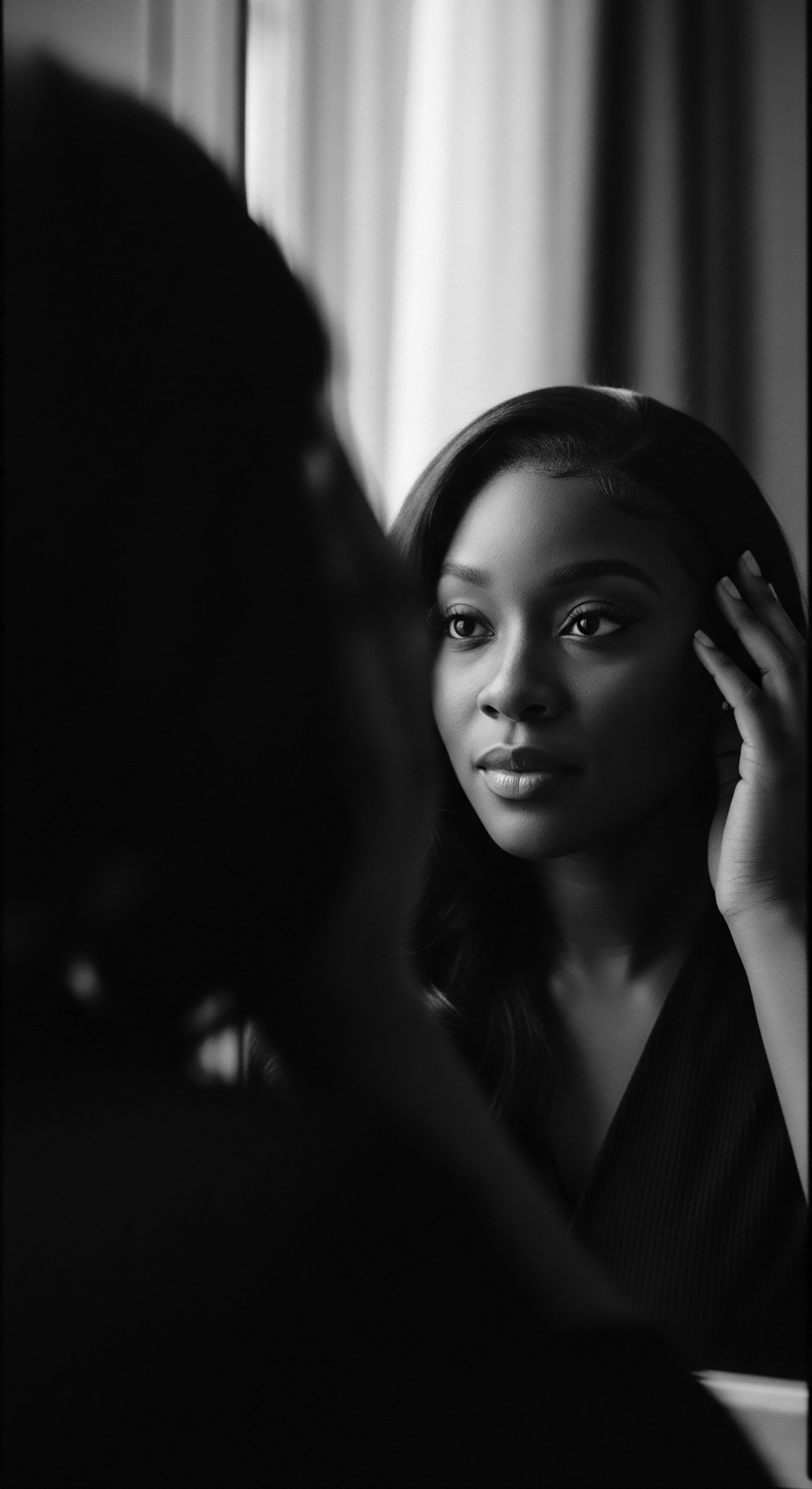
Fundamentals
The understanding of Natural Adornment, particularly as it pertains to textured hair, begins with an appreciation for its inherent qualities. This term speaks to the innate beauty and distinct character of hair in its unaltered state, free from chemical treatments that seek to reshape its natural formation. It is a recognition of the exquisite genetic blueprint that manifests in the spirals, coils, and waves so characteristic of Black and mixed-race hair.
To consider hair as a form of Natural Adornment is to acknowledge its organic structure, its responsiveness to specific care, and its capacity for expressing identity without requiring a departure from its authentic self. The hair, in this context, is viewed not as something needing alteration, but as a living extension of one’s being, deserving of reverence and mindful attention.
This initial meaning of Natural Adornment offers a foundation, helping us understand that what grows from the scalp possesses a unique integrity. It invites us to pause and observe the wondrous ways each strand emerges, curling upon itself, creating a dense crown. The designation emphasizes the beauty found in its untamed state, a state that reflects ancestral ties and a profound connection to the earth.
Early comprehension involves recognizing the physical attributes of different curl patterns, from the tightly coiled formations to the looser, more flowing waves. This diversity within textured hair itself represents a spectrum of Natural Adornment, each type holding its own particular grace.
At its simplest, Natural Adornment refers to the display of hair as it exists without permanent chemical modification, such as relaxers or perms. This approach honors the biological truth of the hair, allowing its original architecture to be the basis for its appearance. The focus turns to enhancing the hair’s inherent qualities through practices that support its health and vitality.
This foundational aspect reminds us that hair, in its natural state, is a powerful visual statement, one that carries echoes of heritage and individual expression. It calls us to observe the way light catches on a coil, the spring in a curl, or the voluminous silhouette that textured hair creates when allowed to simply exist.
Natural Adornment signifies the profound beauty and authentic character of textured hair, embracing its inherent patterns and responding to its unique needs with mindful care.

Elemental Biology and Hair’s Authentic Self
The structural composition of textured hair differs significantly from straight hair, giving rise to its distinctive appearance. Each strand of hair, anchored within the follicle, comprises a cortex, medulla, and cuticle layers. In coiled and curly hair, the follicle itself is often elliptical or flattened, not perfectly round, which influences the hair shaft to twist and turn as it grows. These twists, or points of curvature, are crucial, acting as natural breaking points that make textured hair more susceptible to dryness and breakage if not handled with gentleness.
Understanding this elemental biology is fundamental to appreciating why specific, heritage-rooted care practices evolved for these hair types. The very shape of the strand dictates its needs and vulnerabilities.
Hair, in its authentic self, displays a remarkable ability to absorb and reflect light in various ways depending on its curvature. The numerous bends along a coiled strand mean that light does not reflect uniformly, often giving the hair a less ‘shiny’ appearance compared to straight hair, which has a smoother, more reflective surface. This visual characteristic, far from being a flaw, signifies a different kind of luminosity, a soft glow that arises from the collective density of the curls. Natural Adornment recognizes this attribute as a part of the hair’s inherent glory.
The hair’s organic dryness, too, is a biological truth; the natural oils produced by the scalp struggle to travel down the winding path of a coiled strand as effectively as they do a straight one. This structural reality makes moisture retention a cornerstone of traditional and contemporary natural hair care.

Simple Expressions of Hair Heritage
For those new to the concept, considering Natural Adornment also involves recognizing historical and contemporary expressions of textured hair. This ranges from the simple act of wearing an unbound Afro to carefully crafted twists and braids that respect the hair’s natural growth pattern. These styles, often requiring minimal manipulation and heat, allow the hair to revert to its intrinsic state. This ease of return to original form is a hallmark of natural hair, showcasing its resilience and adaptability.
- Afro Styles ❉ Displaying the hair in its full, unbound glory, celebrating its volume and texture.
- Twists ❉ Created by wrapping two strands of hair around each other, enhancing natural curl patterns and retaining moisture.
- Braids ❉ Formed by interlacing three or more sections, offering protective styling that honors the hair’s density and strength.
These uncomplicated styles, passed down through generations, reveal the earliest forms of Natural Adornment. They represent a straightforward connection to heritage, where functionality and inherent beauty merge. The techniques for crafting these styles often involve only fingers, combs made of natural materials, and plant-based emollients, a practice echoing the wisdom of ancestors who worked in harmony with nature’s offerings.

Intermediate
Building upon basic understandings, Natural Adornment transforms into a deeper exploration, recognizing that hair, particularly textured hair, is a living, breathing archive of identity, tradition, and communal memory. It is a concept that transcends mere aesthetics, encompassing the ancestral practices, the spiritual meanings, and the social narratives woven into the very strands that spring from the scalp. This perspective acknowledges the journey from the elemental biology of the hair to its profound role in expressing an individual’s and a community’s heritage. The meaning deepens as we consider the subtle yet powerful ways hair communicates lineage, status, and belief systems across generations and geographies.
The true significance of Natural Adornment resides in its historical context, particularly for Black and mixed-race communities. For centuries, across various African civilizations, hair was not simply a physical attribute; it acted as a dynamic canvas for social, spiritual, and political declarations. Hairstyles were intricate systems of communication. A person’s coiffure could convey their age, marital status, tribal affiliation, wealth, and even their occupation.
This deep-seated connection to identity meant that hair care was never a trivial matter; it was a communal ritual, an act of kinship, and a generational transfer of knowledge. These practices were rooted in a deep understanding of the hair’s needs and the properties of the earth’s botanicals.
Hair as Natural Adornment stands as a powerful testament to the resilience of cultural identity, echoing ancestral wisdom in every curl and coil.

The Tender Thread ❉ Rituals of Care and Community
The historical rituals surrounding textured hair care offer a rich understanding of Natural Adornment. These were not solitary acts but often communal gatherings, particularly among women. These sessions, extending for hours, provided opportunities for storytelling, mentorship, and the strengthening of bonds.
The hands that tended the hair passed down more than just techniques; they transmitted stories, songs, and the enduring wisdom of previous generations. This tender thread of shared experience is foundational to the communal aspect of Natural Adornment.
- Communal Grooming ❉ Beyond practical care, these gatherings served as vital social events, fostering connection and the exchange of knowledge.
- Generational Instruction ❉ Younger individuals learned the delicate process of detangling, conditioning, and styling from elders, ensuring practices continued.
- Plant-Based Preparations ❉ Ancestral communities utilized a diverse range of indigenous botanicals—shea butter, various oils, and herbal infusions—to condition, strengthen, and cleanse hair, often reflecting local ecosystems. These natural provisions were not just functional but held spiritual meaning, aligning care with nature’s rhythms.
This shared heritage of hair care persists today within Black and mixed-race families, making the “wash day” ritual a cherished tradition. For many, this routine is a tangible link to the past, a continuation of methods honed over centuries to care for hair that demanded specific nourishment and gentle handling. It is a testament to the enduring power of these ancestral care practices, proving their efficacy long before modern science articulated the reasons.
Consider the deep cultural understanding held by the Yoruba People of West Africa, where hair held extraordinary spiritual and social weight. In Yoruba cosmology, the head, or Ori, is considered the seat of a person’s destiny and spiritual essence. As such, hair, as the visible manifestation of the Ori, received meticulous attention and was treated with profound reverence. Hairstyles, often intricate and symbolic, were not merely decorative.
They communicated a person’s identity, their marital status, or even their spiritual alignment with specific deities. For example, certain cults, such as the Ọ̀sun, permitted only specific types of hairstyles and adornments for their priestesses, signifying their devotion and role within the community. (Yorùbá Hair Art and the Agency of Women, ). This particular focus on hair as a sacred, communicative medium underscores the pervasive influence of Natural Adornment in traditional African societies. The methods of styling, the tools used, and the very act of tending to one’s hair were interwoven with a community’s core beliefs and social structure.

Resilience and Reclaiming Identity
The forced disruption of these practices during the transatlantic slave trade represents a painful, yet ultimately powerful, chapter in the heritage of Natural Adornment. Enslaved Africans were often stripped of their cultural identifiers, including their hair. The shaving of heads upon capture was a deliberate act of dehumanization, a cruel attempt to erase their lineage and communal ties (Byrd & Tharps, 2014, p. 10; Sieber & Herreman, 2000,).
Yet, even in the direst circumstances, the spirit of Natural Adornment found ways to persist. Women would use whatever available materials—such as grease for lubrication and metal ornaments, perhaps designed for grooming sheep, for combing—to maintain their hair, demonstrating an unbreakable resolve to preserve aspects of self and heritage (NativeMag, 2020).
A compelling example of this resilience lies in the ingenious use of cornrows. During the era of slavery in the Americas, these intricate braided patterns became more than just a style; they transformed into secret maps and repositories of survival. Historical accounts suggest that Cornrows Were Used to Conceal Seeds for Planting in New Lands, ensuring sustenance and cultural continuity. Beyond this, the very patterns of the braids sometimes encoded escape routes, guiding individuals to freedom through hidden pathways and terrain features (Professional Beauty India, 2023; Byrd & Tharps, 2014, p.
10; Cornrow ❉ A Medium for Communicating Escape Strategies,). This extraordinary adaptation speaks to the profound embeddedness of Natural Adornment within the fight for human dignity and liberty, transforming a form of self-expression into a tangible tool for resistance and survival. The act of braiding, a communal practice rooted in ancestry, became a quiet defiance, a testament to the enduring power of cultural knowledge in the face of oppression.
| Traditional Practice/Ingredient Shea Butter |
| Heritage Significance A staple emollient from West Africa, revered for its moisturizing properties and often used in communal anointing rituals for protection and health. |
| Modern Parallel/Scientific Link Rich in fatty acids and vitamins A and E, providing deep conditioning and sealing moisture, widely present in modern natural hair products for elasticity and reducing breakage. |
| Traditional Practice/Ingredient Herbal Rinses (e.g. Chebe Powder, Hibiscus) |
| Heritage Significance Used in Central and West African traditions to strengthen hair, promote growth, and impart shine; often linked to medicinal and spiritual purification rites. |
| Modern Parallel/Scientific Link Botanical extracts deliver antioxidants and amino acids, improving hair strength, scalp health, and promoting a vibrant appearance, now found in many contemporary hair tonics and masks. |
| Traditional Practice/Ingredient Protective Styling (Braids, Twists) |
| Heritage Significance Preserves hair from environmental elements and daily manipulation, signifying status, age, or spiritual connection in various African cultures; a communal activity. |
| Modern Parallel/Scientific Link Minimizes breakage by reducing friction and exposure, allowing for length retention; scientifically recognized for its role in preventing traction alopecia and promoting hair growth cycles. |
| Traditional Practice/Ingredient These enduring practices underscore the timeless wisdom inherent in Natural Adornment, bridging ancient traditions with contemporary scientific understanding. |
The resurgence of the Natural Hair Movement in the 20th and 21st centuries represents another powerful chapter in this reclamation. This movement, gaining momentum in the 1960s with the “Black is Beautiful” ethos and experiencing a significant revival in the 2000s, encouraged Black women to abandon chemical straighteners and embrace their authentic textures (PubMed, 2025; Ujima Natural Hair,). This shift was not merely a stylistic choice; it was a sociopolitical statement, a rejection of Eurocentric beauty standards that had historically deemed natural Black hair as “unprofessional” or “unacceptable” (Johnson & Bankhead, 2014).
By choosing to wear their hair in its unaltered state, individuals assert a visual connection to their African heritage, fostering a collective consciousness and disrupting harmful narratives (African American Hair and Beauty,). This ongoing transformation continues to affirm the intrinsic beauty and cultural wealth embodied by Natural Adornment.

Academic
The rigorous examination of Natural Adornment, from an academic vantage point, reveals its profound significance as a socio-cultural construct, a biological expression, and a psychological anchor for individuals and communities, especially those of African and mixed heritage. The meaning of Natural Adornment, at its deepest level, constitutes the holistic affirmation of textured hair in its inherent morphological state, conceptualized not as a passive physical attribute but as an active agent of identity, a living repository of ancestral memory, and a dynamic medium for cultural communication and resistance. This delineation transcends simplistic notions of beauty, positing hair as a complex semiotic system, a biological marvel, and a historically contested site of self-determination. It is a declaration of sovereign identity, articulated through the intricate architecture of coil and curl, linking contemporary selfhood to a lineage of embodied knowledge and resilience.
The academic interpretation necessitates a multidisciplinary approach, drawing insights from anthropology, sociology, cultural studies, and even trichology, to dissect the multifaceted nature of this phenomenon. Hair, within this framework, is recognized as a primary marker of racial and group identity within the African diaspora, often holding a weight equivalent to, or even surpassing, skin color or language in its communicative power (Rosado, 2003; Lashley, 2020). This understanding is not an abstract concept; it is grounded in the lived experiences and historical trajectories of millions, revealing how deeply hair is interwoven with perceptions of worth, belonging, and the enduring struggle against oppressive beauty standards.

Echoes from the Source ❉ Hair as an Ancestral Archive
The biological particularities of textured hair, characterized by its elliptical follicles and numerous points of curvature, contribute to its inherent dryness and susceptibility to breakage. Yet, these same characteristics are the source of its unique volume, versatility, and sculptural capacity. This biological reality informed ancestral care practices long before the advent of modern scientific inquiry. Traditional African societies possessed a sophisticated understanding of botanical properties, utilizing a diverse pharmacopeia of natural butters, oils, and herbs to maintain hair health.
These practices, such as the use of shea butter or the incorporation of strengthening herbal rinses, represent an ancient form of applied trichology, validating the efficacy of indigenous knowledge systems. The consistent application of natural emollients helped compensate for the challenge of natural sebum distribution along the curved hair shaft, directly addressing moisture retention, a fundamental need for coiled textures (Davis-Sivasothy, 2011,).
Hair, from this academic perspective, functions as a tangible link to an ancient past, a ‘braided archive’ of collective experience. It carries echoes of traditional cosmology where the head, being the highest point of the body, served as a conduit for spiritual connection and divine communication (africa.com,; Marie Claire Nigeria, 2025; ResearchGate,). The act of hair grooming was therefore imbued with ritualistic significance, often performed by trusted relatives to safeguard the individual’s spiritual essence.
The intricate patterns of braids or styles often conveyed not only social status and tribal affiliation but also spiritual messages or protective symbolism, transforming hair into a living scripture of cultural narratives (Afriklens, 2024; Marie Claire Nigeria, 2025). This deep embedding of hair in socio-spiritual life meant its care was a communal practice, a space for intergenerational knowledge transfer and social bonding.
Natural Adornment, viewed academically, is a profound declaration of embodied heritage, a living text written in the very structure of textured hair that resists and reclaims identity.
The forceful shaving of hair during the transatlantic slave trade represents a stark illustration of the power hair held as a cultural marker. This act was a deliberate strategy of cultural erasure and dehumanization, a calculated attempt to sever enslaved individuals from their identity and ancestral ties (Byrd & Tharps, 2014, p. 10; Sieber & Herreman, 2000). Yet, even in the crucible of enslavement, hair became a site of covert resistance.
The compelling case study of cornrows, ingeniously used to map escape routes or conceal precious seeds, demonstrates a profound level of cognitive and cultural resilience (Professional Beauty India, 2023; Byrd & Tharps, 2014, p. 10). This historical example reveals how a form of Natural Adornment transcended its aesthetic function, becoming a vital, clandestine mechanism for survival and liberation, solidifying its role as an enduring symbol of defiance and ingenuity.

The Unbound Helix ❉ Identity, Resilience, and Contemporary Narratives
The re-emergence of Natural Adornment in contemporary society, often termed the ‘Natural Hair Movement,’ is not a fleeting trend but a significant socio-cultural phenomenon rooted in a long history of resistance and reclamation. This movement, particularly pronounced from the 1960s Civil Rights era and gaining renewed momentum in the early 2000s, represents a conscious rejection of Eurocentric beauty ideals that historically devalued kinky and coiled textures (Thompson, 2001; Johnson & Bankhead, 2014). Academic research highlights the persistent discrimination faced by individuals with natural hairstyles in professional and educational settings. A CROWN 2023 Research Study, for instance, revealed that 41% of Black women felt compelled to alter their hair from curly to straight for job interviews, with 54% believing straight hair was a prerequisite for such occasions (Ujima Natural Hair,).
This quantitative insight underscores the ongoing systemic bias against natural textured hair, revealing the tangible consequences of deeply ingrained societal prejudices. The continued legislative efforts, such as the CROWN Act, to prohibit race-based hair discrimination across various U.S. states, further attest to the enduring need to protect and validate Natural Adornment within institutional spaces (Harvard Gazette, 2025).
The psychological impact of embracing Natural Adornment is also a critical area of study. Research indicates a positive association between wearing natural hair and increased self-esteem and identity affirmation among Black women (Johnson & Bankhead, 2014). Conversely, the suppression of ethnic identity, often through hair alteration, has been linked to negative psychological consequences, including cognitive deterioration, higher levels of depression, and reduced self-esteem (Shih et al.
2013, cited in Natural Hair Bias,). This intricate connection between hair expression and mental well-being positions Natural Adornment as a vital component of holistic selfhood, challenging oppressive narratives and promoting a sense of authenticity.
The discourse surrounding Natural Adornment also intersects with the commercial landscape. The Black hair care market, valued at billions of dollars, presents complex dynamics. While there is a growing demand for products that cater to natural hair, concerns remain about the ownership and representation within this industry (NativeMag, 2020).
Academic analyses consider how online natural hair communities serve as crucial platforms for knowledge dissemination, product review, and collective empowerment, often debunking myths and promoting DIY approaches that echo ancestral self-sufficiency (Smith Scholarworks,). These digital spaces reinforce the communal aspect of hair care, adapting ancient practices to contemporary platforms.
The exploration of Natural Adornment through these lenses provides a comprehensive understanding that extends beyond superficial definitions. It acknowledges hair as a dynamic entity, deeply embedded in personal and collective history, continually shaped by biological truths, cultural legacies, and ongoing struggles for recognition and liberation. It speaks to a conscious choice to honor genetic heritage, to engage with practices passed through generations, and to express identity with profound authenticity.
- Epistemological Shift ❉ The understanding of hair care moves from mere cosmetic application to a sophisticated body of knowledge informed by ancestral observation and adapted to biological realities.
- Socio-Political Symbolism ❉ Hair becomes a potent emblem of resistance, agency, and collective identity against dominant, often Eurocentric, beauty paradigms.
- Psychological Well-Being ❉ The adoption and celebration of Natural Adornment contribute significantly to self-acceptance, cultural pride, and overall mental health for individuals within the diaspora.
- Economic and Cultural Autonomy ❉ The natural hair movement encourages and supports independent entrepreneurship and community-driven knowledge sharing, fostering a degree of economic and cultural self-reliance.

Reflection on the Heritage of Natural Adornment
As we consider the journey of Natural Adornment, from the whispers of ancient earth to the vibrant expressions of today, a singular truth resonates ❉ textured hair is a profound testament to heritage. It carries not just pigment and protein, but the indelible marks of countless generations. Each coil and strand holds stories of survival, artistry, community, and an unyielding spirit. The path of Natural Adornment, for Black and mixed-race communities, is a continuous dialogue with the past, a living celebration of what was preserved, adapted, and reclaimed.
This enduring legacy reminds us that care for textured hair is more than a routine; it is a sacred practice, a continuation of ancestral wisdom. It is a quiet, yet powerful, act of remembrance, connecting us to the hands that once braided in moonlight, to the herbs gathered from forgotten fields, and to the indomitable will that transformed tools of oppression into pathways to freedom. The very act of honoring hair in its natural state becomes a profound affirmation of self, a grounding presence in a world that often seeks to standardize and erase.
The journey has shown us that the biological reality of textured hair is inextricably linked to its cultural significance. The science of its structure validates the intuitive wisdom of our forebears, revealing how their ingenious methods were often a direct response to the hair’s unique needs. This blending of ancient practice with contemporary understanding strengthens our appreciation for the holistic nature of Natural Adornment—a concept that nourishes both the physical strand and the soulful connection to lineage.
Ultimately, Natural Adornment embodies the “Soul of a Strand” ethos ❉ that within each curl lies a universe of history, identity, and spirit. It is a call to recognize the inherent divinity within textured hair, to respect its resilience, and to uphold its place as a crown of living heritage. This ongoing narrative of hair, far from being concluded, continues to unfold with every wash, every twist, every style that honors its authentic, glorious nature. It stands as a timeless beacon, guiding us to remember where we come from and to stride forward with profound pride in our authentic selves.

References
- Byrd, A. & Tharps, L. D. (2014). Hair Story ❉ Untangling the Roots of Black Hair in America. St. Martin’s Griffin.
- Dabiri, E. (2020). Twisted ❉ The Tangled History of Black Hair Culture. Harper Perennial.
- Davis-Sivasothy, A. (2011). The Science of Black Hair ❉ A Comprehensive Guide to Textured Hair Care. Sivasothy Hair.
- Johnson, T. A. & Bankhead, T. (2014). Hair It Is ❉ Examining the Experiences of Black Women with Natural Hair. Open Journal of Social Sciences, 2, 86-100.
- Omotos, A. (2018). The “Dreaded” Colonial Legacy. Journal of Pan African Studies, (Paper available via Gale OneFile ❉ World History).
- Rosado, S. D. (2003). No Nubian Knots or Nappy Locks ❉ Discussing the Politics of Hair Among Women of African Decent in the Diaspora. A Report on Research, pp. 58-69.
- Sieber, R. & Herreman, F. (2000). Hair in African Art and Culture. The Museum for African Art.
- Thompson, V. L. S. (2001). The Complexity of African American Racial Identification. Journal of Black Studies, 32, 155-165.
- Shih, M. Ambady, N. Richeson, J. A. Fujita, K. & Gray, H. M. (2013). Suppressing identity ❉ How attempts to hide a stigmatized identity affect well-being. Psychological Science.
